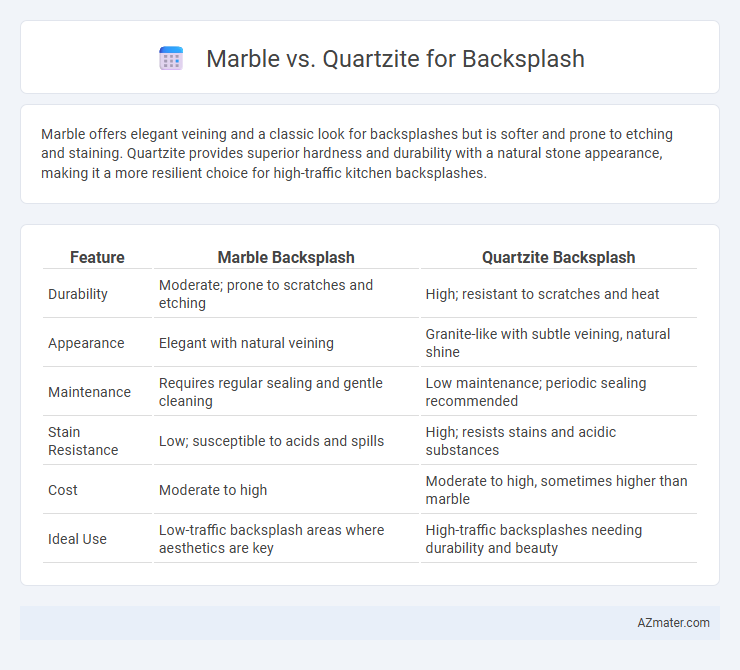Marble offers elegant veining and a classic look for backsplashes but is softer and prone to etching and staining. Quartzite provides superior hardness and durability with a natural stone appearance, making it a more resilient choice for high-traffic kitchen backsplashes.
Table of Comparison
| Feature | Marble Backsplash | Quartzite Backsplash |
|---|---|---|
| Durability | Moderate; prone to scratches and etching | High; resistant to scratches and heat |
| Appearance | Elegant with natural veining | Granite-like with subtle veining, natural shine |
| Maintenance | Requires regular sealing and gentle cleaning | Low maintenance; periodic sealing recommended |
| Stain Resistance | Low; susceptible to acids and spills | High; resists stains and acidic substances |
| Cost | Moderate to high | Moderate to high, sometimes higher than marble |
| Ideal Use | Low-traffic backsplash areas where aesthetics are key | High-traffic backsplashes needing durability and beauty |
Introduction to Marble and Quartzite Backsplashes
Marble backsplashes offer timeless elegance with natural veining and a smooth, polished surface that enhances kitchen aesthetics. Quartzite backsplashes provide exceptional durability, combining the beauty of marble with resistance to scratches and heat, making them ideal for busy cooking spaces. Both materials bring unique textures and colors, but quartzite's hardness often outperforms marble in longevity and maintenance.
Comparing Aesthetic Appeal: Marble vs Quartzite
Marble offers classic elegance with its smooth veining and wide variety of color options, creating a timeless and luxurious backsplash. Quartzite provides a more natural, rugged look with subtle sparkle and durability, making it ideal for a modern or rustic kitchen design. Both materials bring unique visual textures, but marble's polished surface contrasts with quartzite's more varied and often matte finish, influencing the overall aesthetic impact.
Durability and Strength: Which Material Lasts Longer?
Quartzite outperforms marble in durability and strength, making it a more long-lasting choice for backsplashes. Marble is softer and more prone to scratching, chipping, and etching from acidic substances, whereas quartzite's natural hardness resists wear, heat, and chemical damage more effectively. The superior density and minimal porosity of quartzite ensure better longevity and sustained aesthetic appeal compared to marble in high-use kitchen environments.
Maintenance Requirements for Marble and Quartzite
Marble backsplashes require regular sealing and gentle cleaning with pH-neutral products to prevent staining and etching from acidic substances, making maintenance more intensive compared to quartzite. Quartzite offers greater durability and resistance to scratches and stains, needing less frequent sealing and simpler upkeep to retain its polished appearance. Both materials benefit from prompt spill management, but quartzite's hardness significantly reduces the risk of damage in high-traffic kitchen areas.
Stain and Heat Resistance Differences
Marble backsplashes are prone to staining due to their porous nature, making them susceptible to oils, acids, and spills, whereas quartzite offers superior stain resistance thanks to its denser composition. In terms of heat resistance, quartzite withstands higher temperatures without damage or discoloration, while marble can etch or discolor when exposed to prolonged heat. Homeowners seeking durable backsplashes with minimal maintenance often prefer quartzite over marble for its enhanced stain and heat resistance qualities.
Installation Considerations for Both Materials
Marble requires careful sealing and frequent maintenance due to its porous nature, making it more susceptible to stains and etching when used as a backsplash. Quartzite offers greater durability and resistance to heat and scratching, allowing for easier installation with fewer concerns about damage during cutting or fitting. Both materials benefit from professional installation to ensure proper sealing, precise cuts, and secure mounting, but quartzite's enhanced hardness may necessitate specialized tools for cutting and drilling.
Cost Comparison: Marble vs Quartzite Backsplash
Marble backsplashes typically cost between $40 and $150 per square foot, reflecting their luxurious appearance and softer nature, which may increase maintenance expenses. Quartzite backsplashes range from $70 to $200 per square foot, offering greater durability and resistance to heat and scratches, justifying the higher initial investment. Choosing quartzite can provide long-term cost savings due to its lower upkeep and enhanced durability compared to marble.
Popular Design Trends Using Marble and Quartzite
Marble backsplashes remain a timeless design trend favored for their elegant veining and classic appeal, effortlessly elevating kitchen aesthetics with a luxurious, polished finish. Quartzite has gained popularity as a durable alternative, offering similar visual appeal with increased resistance to heat and scratches, making it ideal for busy cooking areas. Modern designs often blend marble's softer, intricate patterns with quartzite's bold, natural textures to create striking, multi-dimensional backsplashes that enhance both style and functionality.
Pros and Cons: Marble vs Quartzite for Backsplash
Marble backsplashes showcase elegant veining and naturally cool tones, offering a classic aesthetic but require regular sealing due to their porosity and susceptibility to staining and etching from acidic substances. Quartzite provides superior durability and resistance to heat and scratches, making it ideal for busy kitchens, though it typically comes at a higher cost and less variety in pattern compared to marble. Both materials demand periodic maintenance, but quartzite's hardness and stain resistance often make it the more practical choice for long-term kitchen use.
Choosing the Best Option for Your Kitchen or Bathroom
Marble offers a classic, elegant look with natural veining that enhances kitchen and bathroom backsplashes but requires regular sealing due to its porous nature. Quartzite is a durable, scratch-resistant alternative with a similar aesthetic to marble, making it ideal for high-traffic areas that demand low maintenance and long-lasting beauty. When choosing between marble and quartzite, consider factors like moisture exposure, durability needs, and maintenance preferences to select the best material for your backsplash.

Infographic: Marble vs Quartzite for Backsplash
 azmater.com
azmater.com